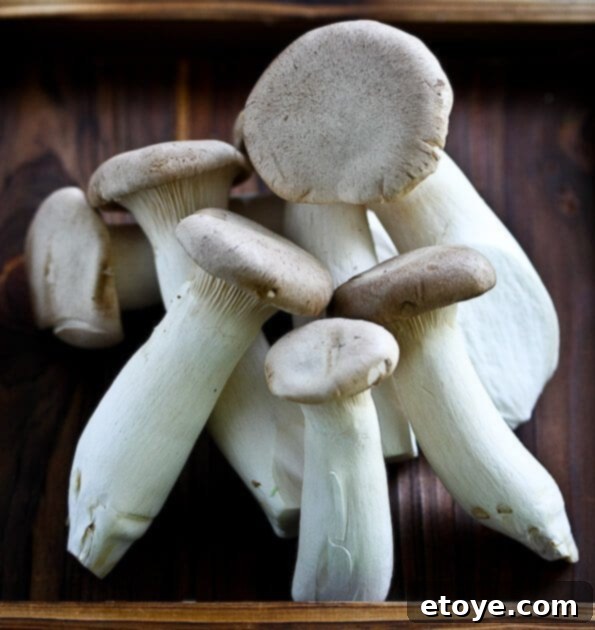Shiitake, Maitake, Brown Beech, and more: mushrooms are an important part of Japanese cuisine. There so many ways to enjoy these delicious mushrooms! Read on for some awesome Japanese Mushroom recipes and how to identify the different kinds in the supermarket.
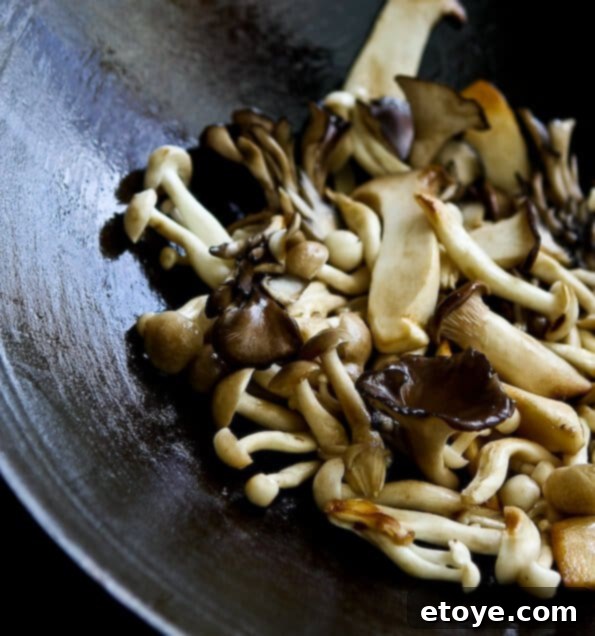
I’ve been playing around with Japanese mushrooms lately. Look at these babies! From left to right, these are White Beech Mushrooms (Bunapi Shimeji), Brown Beech Mushrooms (Buna Shimeji), Maitake Mushrooms and King Trumpet Mushrooms (Eryngii)

These are organic and grown in the United States (the ones sold in US are grown in California) and even cultivated on recyclable material with no chemicals or additives. Japanese mushroom farm at Hokto Kinoko:




Discover the Exquisite World of Japanese Mushrooms: Varieties, Benefits, and Recipes
Japanese cuisine is renowned for its delicate flavors, artistic presentation, and the thoughtful incorporation of natural ingredients. Among these, mushrooms hold a revered place, offering a delightful array of textures, aromas, and tastes that enrich countless dishes. From the delicate elegance of Shimeji to the robust heartiness of King Trumpet, these fungi are not just ingredients; they are culinary gems that elevate everyday meals into extraordinary dining experiences. This guide explores the fascinating world of popular Japanese mushrooms, offering insights into their unique characteristics, health benefits, and versatile culinary applications, complete with delicious recipes to inspire your next meal.
I took some time to give each mushroom variety a glamor shot – these were really fun to photograph. I hope you enjoy them!
Exploring Popular Japanese Mushroom Varieties
The diversity of Japanese mushrooms is truly remarkable. While each type brings its distinct character to the table, they all share a common thread of enhancing dishes with their earthy essence. Let’s delve into some of the most beloved varieties you’ll find, often cultivated with care and available fresh in supermarkets around the globe.
Brown Beech Mushrooms (Buna Shimeji)

The Buna Shimeji, commonly known as Brown Beech Mushroom, holds the distinction of being the third most popular mushroom in Japan, following Shiitake and Enoki. These elegant mushrooms are named “beech mushrooms” due to their natural tendency to flourish on fallen beech trees. Visually, they are captivating, featuring pristine white bases that give way to charming, speckled brown caps. Despite their striking appearance, Buna Shimeji mushrooms are surprisingly odorless when raw. However, their true magic unfolds upon cooking, revealing a delightful texture that is simultaneously smooth and crunchy, accompanied by a rich, nutty, and buttery flavor profile. It’s crucial to remember that Shimeji mushrooms must always be cooked and should never be consumed raw. Their unique qualities make them an exceptional pairing for noodles, stir-fries, and soups, adding a layer of sophisticated flavor to any dish.
Delightful Recipes Featuring Shimeji Mushrooms
Shimeji mushrooms are incredibly versatile, lending themselves to a wide range of culinary creations. Their firm texture and distinct nutty flavor stand up well to various cooking methods, making them a favorite among chefs and home cooks alike. Here are some fantastic recipes that highlight the best of Buna Shimeji:
Vegetarian Japanese Shimeji Mushroom Omelet
A simple yet incredibly satisfying vegetarian omelet that’s savory, delightfully cheesy, and packed with wholesome goodness. This recipe’s original inspiration came from the renowned health spa, Rancho La Puerta, in Mexico, promising a healthy and delicious start to your day.
15 Minute Japanese Mushroom Flatbread
This recipe offers the quickest gourmet-style appetizer imaginable. Utilizing convenient naan flatbreads as the base provides a fantastic shortcut, as they are pre-baked, eliminating the need to roll out your own pizza dough and saving precious time.
15 Minute Udon Miso Noodle Soup with Japanese Shimeji Mushrooms
Experience Japanese-style fast food at its finest! From start to finish, this healthy, light, and wonderfully comforting Japanese Udon Noodle Soup with Miso can be prepared in less than 15 minutes, making it perfect for a quick and nutritious meal.
Japanese Noodles with Shimeji Mushrooms Recipe
A remarkably easy and delicious Japanese mushroom noodle dish that can be prepared in just 20 minutes. Its simplicity belies its incredible flavor, making it a perfect weeknight meal.
Truffled Potatoes with Shimeji Recipe
For this luxurious recipe, a small spoonful of aromatic truffle cream is stirred into the finished dish. The residual heat gently works its magic, releasing and infusing all the ingredients with the exquisite, earthy goodness of white truffle, creating a truly decadent side.
Shimeji Mushrooms with Aburage Miso Soup Recipe
This remarkably tasty miso soup is a symphony of flavors and textures, with the delicate Shimeji mushrooms complementing the savory aburage (fried tofu pouches) and aromatic dill for a truly comforting bowl.
Steak with Shimeji Mushrooms Recipe
This exceptional recipe promises perfectly cooked steak every time, crowned with an exceptionally delicious mushroom sauce made with Shimeji, elevating a classic dish to new heights of flavor and sophistication.
White Beech Mushrooms (Bunapi Shimeji)
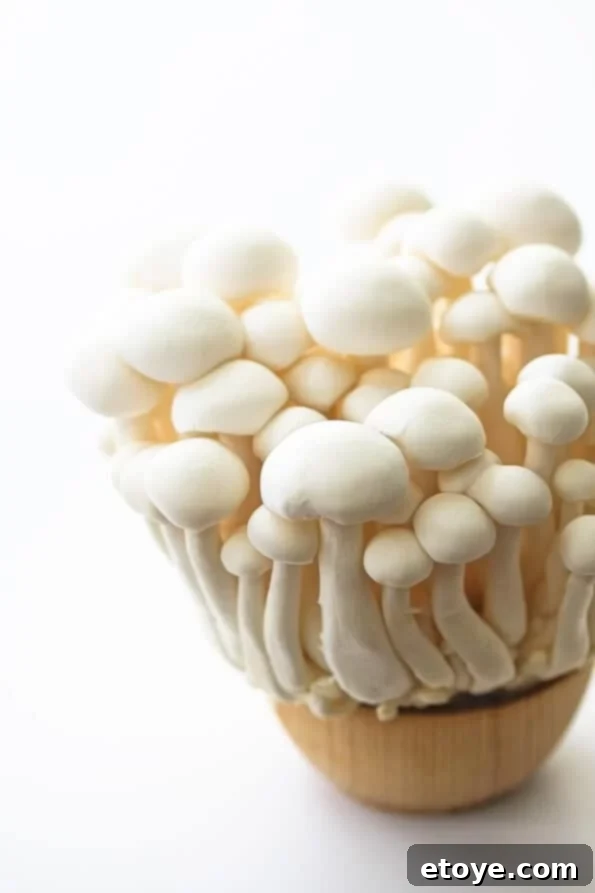
The elegant White Beech Mushroom, known as Bunapi Shimeji, is a cultivar specially bred by Hokuto. “Bunapi” is actually a trademark, representing their success in developing this particular mushroom from the Buna Shimeji (Brown Beech) to achieve its distinctively smooth, ivory color. Beyond its striking aesthetic, the Bunapi shares a very similar delicate flavor and satisfying texture profile with its brown counterpart. This means that any recipe that calls for Buna Shimeji can be confidently prepared using Bunapi, offering a visually lighter option without compromising on taste or culinary performance. They maintain their firm, crunchy texture when cooked and possess that signature nutty, buttery flavor, making them equally versatile in stir-fries, soups, and noodle dishes.
Maitake Mushrooms (“Dancing Mushroom”)
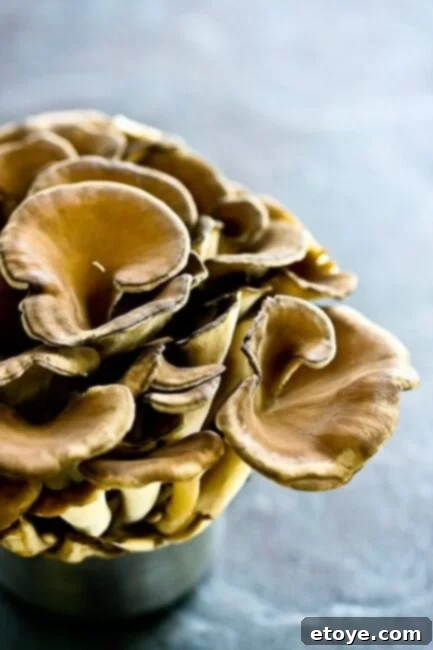
The Maitake mushroom, scientifically known as Grifola frondosa, is a fascinating and highly prized fungus. Its Japanese name, Maitake, translates to “dancing mushroom,” a moniker believed to originate from ancient times when people would dance with joy upon finding this elusive and valuable mushroom in the wild. Another common name for Maitake is “Hen of the Woods,” due to its distinctive ruffled, fan-like clusters that resemble a hen’s feathers. This mushroom is celebrated for its sturdy structure, which beautifully holds its shape even during quick stir-fries, and its elegant swirls and curls add a picturesque quality when floating in soups. The flavor profile of Maitake is rich, earthy, and distinctly woodsy, complemented by a wonderfully crisp yet firm texture. Beyond its culinary appeal, Maitake is also revered in traditional medicine for its potential health benefits, including immune support.
Irresistible Maitake Mushroom Recipes
Maitake mushrooms’ robust flavor and texture make them an excellent addition to a variety of dishes, from simple pasta to hearty steaks. Their ability to absorb flavors while maintaining their own unique character ensures a memorable meal. Explore these delightful Maitake recipes:
Warm Maitake Pasta with Citrus Soy Dressing
A super simple yet profoundly flavorful pasta recipe that features the earthy notes of Maitake mushrooms perfectly complemented by a bright and zesty citrus soy dressing. This dish is both comforting and refreshing.
Steak with Creamy Whisky Mushroom Sauce
Indulge in a rich, decadent steak experience with this flexible recipe. The creamy whisky mushroom sauce, featuring Maitake, adds an unparalleled depth of flavor, making any steak dinner feel exceptionally gourmet and satisfying.
Seared Maitake Mushrooms
At Vedge in Philadelphia, chef Richard Landau masterfully entices carnivores to his acclaimed vegan spot by making a bold statement with these dramatic, exquisitely crispy seared Maitake mushrooms. A testament to their versatility.
Maitake Sea Bass Recipe
This elegant dish requires thick, firm-fleshed fish fillets to withstand the high heat of pan-roasting; sea bass is an ideal choice as its skin crisps up beautifully. The Maitake mushrooms add a wonderful earthy counterpoint to the delicate fish, with tilefish making a good alternative.
Maitake Mushroom & Asparagus Stir Fry Recipe
An easy, quick, and utterly delicious stir-fry that perfectly pairs the robust flavor of Maitake mushrooms with the crisp freshness of asparagus – a truly harmonious and healthy combination.
Maitake and Beech Mushrooms with Simmered Tofu on Sesame Rice Recipe
This recipe offers a delightful combination of perfectly cooked Maitake and Beech mushrooms, simmered with tender tofu, all served atop beautifully seasoned sesame rice for a wholesome and flavorful plant-based meal.
Cauliflower Steaks with Maitake in Brown Butter Sauce
Nearly a full, incredibly satisfying meal in itself – a knife-and-fork dish that brilliantly highlights the natural flavors of vegetables. Maitake mushrooms, also known as hen-of-the-woods, contribute a robust, nutty flavor that exquisitely complements the cauliflower steaks. If Maitake are unavailable, a handful of another favorite mushroom can be substituted.
King Trumpet Mushrooms (Eryngii or King Oyster)
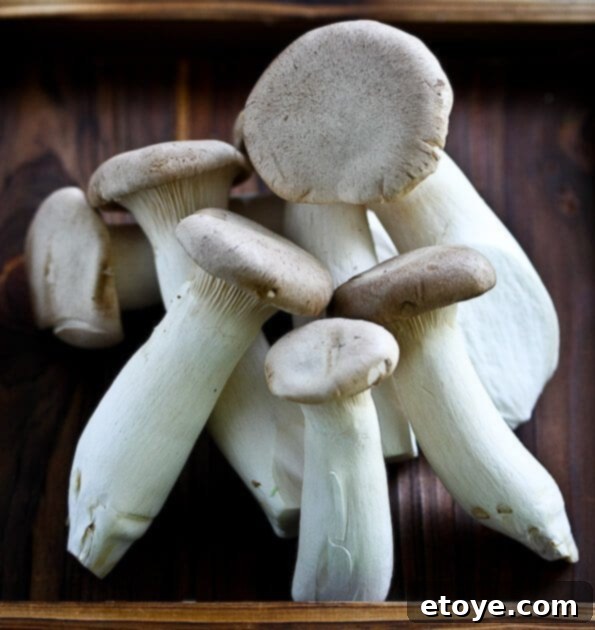
The King Trumpet mushroom, also known as Eryngii or King Oyster mushroom, stands out as one of my absolute favorites, primarily due to its incredibly hearty and meaty texture. This quality makes it an excellent meat substitute in many dishes, offering a satisfying bite that can mimic scallops, calamari, or even steak. I particularly enjoy slicing these magnificent mushrooms into 1/4-inch rounds and pan-frying them until golden brown, enhanced with a touch of butter, a splash of mirin, and a dash of soy sauce. (A dedicated recipe for this simple preparation will be shared soon!).
King Trumpet mushrooms boast a sweet, mild, and distinctly buttery flavor. Their distinguishing feature is a thick, robust stem, and they are closely related to the common Oyster Mushroom. The specimens shown here, typically 3 to 4-inches tall with a base diameter of about 3/4-inch, are truly “big boys!” Ian Garrone provides a helpful short video clip on Chow.com, offering tips on what to look for when purchasing King Trumpet mushrooms. He also notes their taste similarity to abalone, a sentiment I wholeheartedly agree with, making them a fantastic, sustainable alternative to seafood.
Savoring King Trumpet Mushroom Dishes
With their firm texture and mild flavor, King Trumpet mushrooms are incredibly adaptable, capable of starring in both simple and elaborate dishes. Their ability to take on the flavors of their accompanying ingredients while providing a substantial bite makes them a chef’s delight. Here are some inspired recipes:
Teriyaki Mushroom Sauce with Grilled Salmon
Elevate your grilled salmon (or steak!) with this exquisite teriyaki mushroom sauce. Simply sauté the King Trumpet mushrooms until tender, then stir in the savory teriyaki sauce. A minute of simmering is all it takes for this flavorful topping, perfect not just for grilled proteins but also for pouring generously over steamed rice.
10-Minute Shrimp and Mushroom Thai Curry
This quick and easy Thai curry is my go-to “break in case of emergency” meal. With staples like coconut milk, curry paste, frozen shrimp, and a medley of miscellaneous vegetables always on hand, and rice just a “one-finger trigger button” away (or already cooked and frozen), this vibrant dish comes together in a flash, featuring hearty King Trumpet mushrooms.
Arctic Char with King Trumpet Mushrooms and Lemon Butter Sauce Recipe
A truly delicious and elegant fish dish starring Arctic Char, complemented by an utterly divine lemon butter sauce, and graced with the glorious presence of King Trumpet mushrooms for added texture and depth of flavor.
King Oyster “Scallop” Bowl
This recipe transforms King Oyster mushrooms into impressive “scallops.” It’s an easy dish that requires minimal equipment (no food processor or blender needed), though some preparation is involved. These wholesome bowls feature sautéed King Oyster mushrooms, spicy peanut tofu, perfectly steamed baby bok choy, and soba noodles, all beautifully seasoned with a drizzle of sesame oil and fresh chives.
Health Benefits of Incorporating Japanese Mushrooms into Your Diet
Beyond their incredible flavors and textures, Japanese mushrooms are nutritional powerhouses. They are generally low in calories and fat, yet rich in essential vitamins, minerals, and dietary fiber. Many varieties, including Maitake and Shimeji, are known for their immune-boosting properties, thanks to compounds like beta-glucans. They often contain antioxidants, which help combat oxidative stress in the body, and some even provide a natural source of Vitamin D when exposed to UV light during cultivation. Regular consumption of these fantastic fungi can contribute to a balanced diet, supporting overall wellness and adding a delicious, earthy dimension to your meals.
Tips for Buying and Storing Fresh Japanese Mushrooms
To ensure you get the most out of your Japanese mushrooms, proper selection and storage are key. When buying, look for mushrooms that are firm, free from blemishes, and have a fresh, earthy scent. Avoid any that appear slimy, dried out, or discolored. Store fresh mushrooms in a paper bag in the refrigerator; this allows them to breathe and prevents moisture buildup, which can lead to spoilage. Avoid storing them in plastic bags, as this traps moisture. Most varieties will keep well for up to a week when stored correctly, ready to be transformed into your next culinary masterpiece.
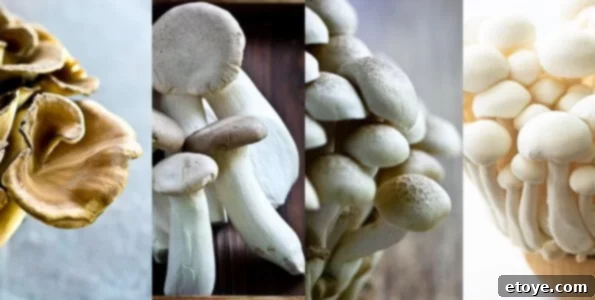
Embark on Your Japanese Mushroom Culinary Journey
From the subtle sweetness of Bunapi Shimeji to the robust, umami-rich notes of Maitake and the satisfying chew of King Trumpet, Japanese mushrooms offer an unparalleled array of sensory experiences. Their versatility makes them suitable for a wide range of dishes, from light soups and salads to hearty stir-fries and even as a centerpiece. Incorporating these healthy and flavorful fungi into your cooking is an excellent way to explore new tastes, embrace a more plant-forward diet, and bring the rich culinary traditions of Japan into your own kitchen. We hope this guide has inspired you to experiment with these incredible ingredients and discover your own favorite ways to enjoy them.
